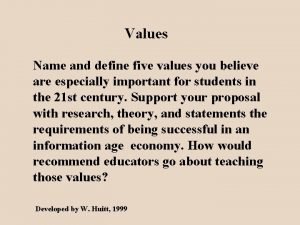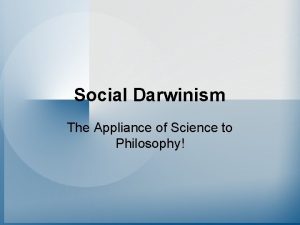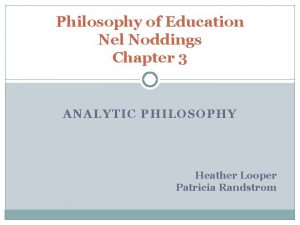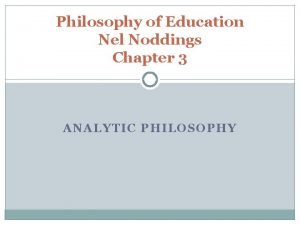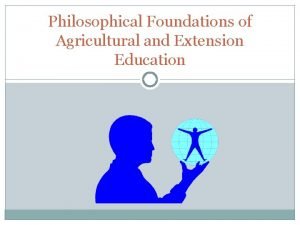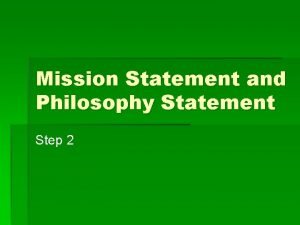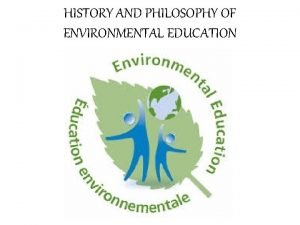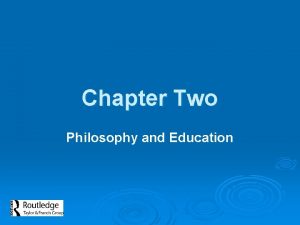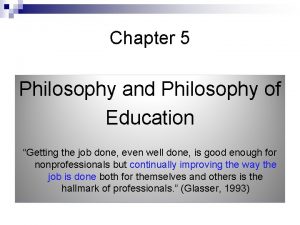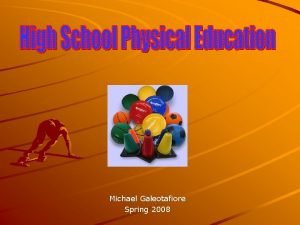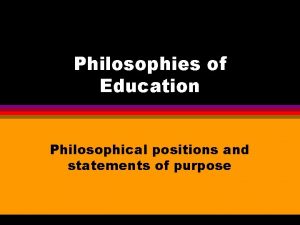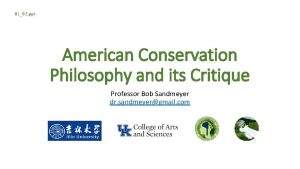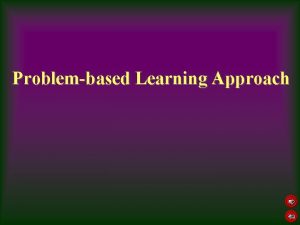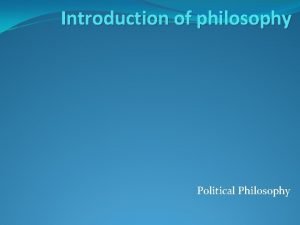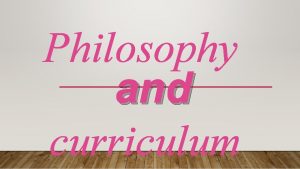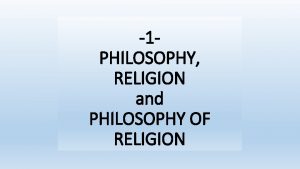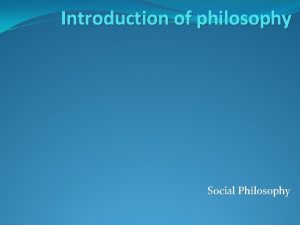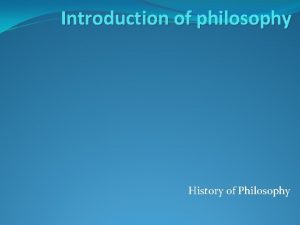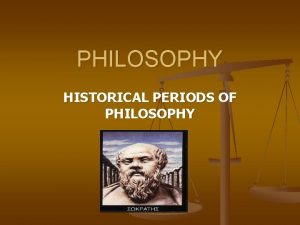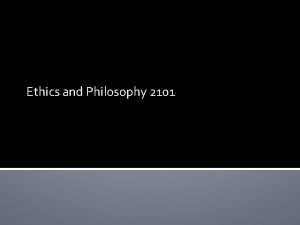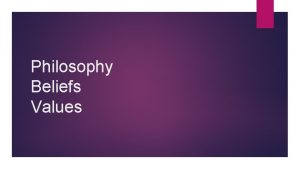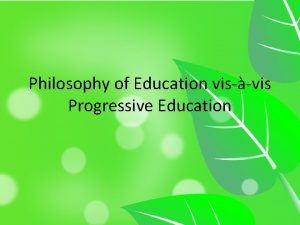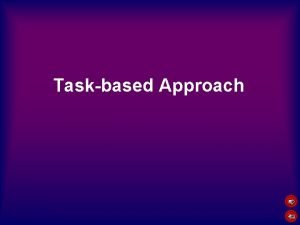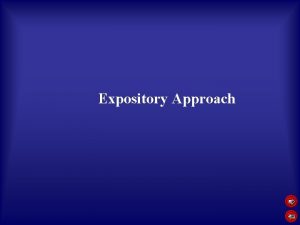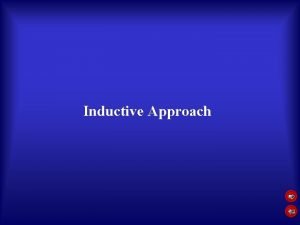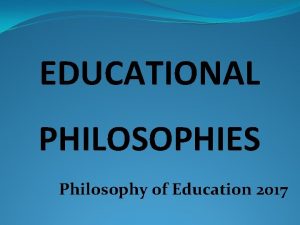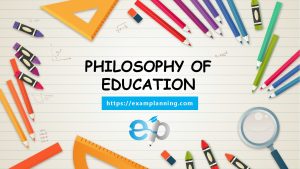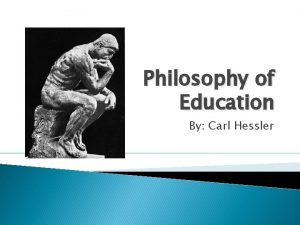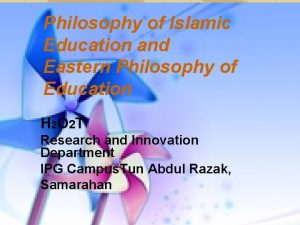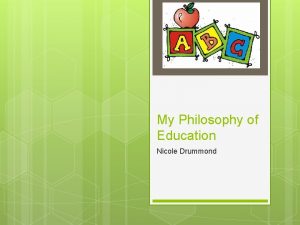SocialConstructivist Approach Education Philosophy SocialConstructivist Approach learning is





















- Slides: 21

Social-Constructivist Approach

Education Philosophy Social-Constructivist Approach • learning is claimed to be achieved by sharing, discussing and critically reviewing own and others ideas/products • this paradigm treasures and values the establishment of a strong cooperative and collaborative culture within a knowledge-building community • students can learn, construct new knowledge and relate new knowledge to prior knowledge through interacting with others • interaction, sharing and discussion are significant to the lessons

Education Philosophy Social-Constructivist Approach • this approach often being used with Task-based Approach or Problem-based Learning Approach • apart from students’ understanding about the subject matter knowledge, social -constructivist approach aims at helping students to develop their metacognitive abilities and higher order thinking skills, such as • reflective thinking skills • critical thinking skills • skills of constructing knowledge through working cooperatively and collaboratively with others

Roles of Teachers & Students Social-Constructivist Approach • students play the role of the co-builders of knowledge • students have to response to challenges, review own and other works/ideas critically • teacher would design classroom activities in which students can attain knowledge co-construction & exploration • teacher does not see their primary role as that of an expert but rather as someone who poses challenges to students and responses students’ discussions

Learning Process Social-Constructivist Approach The number of lessons that this approach may take depends on the discussion topic and its demanded answers. The learning flow includes: 1. Teacher states the discussion topic 2. Students organize their points of view on their own or in groups 3. Students’ presentation 4. Students’ discussion 5. Teachers’ feedback

Role of IT Social-Constructivist Approach IT tools play a significant role in presenting information/idea effectively and this includes: • Technology as an effective and attractive means of presentation • On-line Discussion Forum

Examples Social-Constructivist Approach Lesson Video Clips S. 4 & 5 GPA S. 5 English

S. 4 & 5 GPA Dismissal of the Urban & Regional Councils Lesson Goals Lesson Outcome Lesson Outline Lesson Video Clips Equipment & Technological Competence Requirements Your Reflection

Lesson Goals Dismissal of the Urban & Regional Councils 1. Form 4 students can learn knowledge about “Dismissal of the Urban & Regional Councils”. 2. Form 5 students can renew their knowledge about “Dismissal of the Urban & Regional Councils”. 3. Form 4 students can learn the positive learning attitude and critically thinking skill from Form 5 students.

Lesson Outcome Dismissal of the Urban & Regional Councils 1. Form 4 students can learn knowledge about “Dismissal of the Urban & Regional Councils”. 2. Form 5 students can renew their knowledge about “Dismissal of the Urban & Regional Councils”.

Lesson Outline S. 4 & 5 GPA 1. Lesson Objectives and Discussion Topic Teacher states the lesson objectives and the discussion topic 2. Group Presentation F. 4 students’ presentation 3. Students’ Discussion between F. 5 and F. 4 students 4. Teacher’s feedback Teacher provides feedback to F. 5 and F. 4 students

Lesson Video Clips S. 4 & 5 GPA

Equipment & Technological Competence Requirements Venue No. of Student S. 4 & 5 GPA • classroom • about 70 Teacher’s Technological Competence • Power. Point Operation Students’ Technological Competence • Power. Point Operation Equipment • 1 computer • Power. Point • Data Projector & Screen

Your Reflection S. 4 & 5 GPA 1. What kind of discussion can benefit students’ learning? How will you help your students to undergo such kind of discussion? 2. What challenges teacher has to face in this approach? How will you equip yourself?

S. 5 English The Clinton Scandal This lesson is the second part of the whole learning unit: The First Part: Students learn vocabulary and expressions from some newspaper articles and then write a composition about the Clinton Scandal. The Second Part: Students search for relevant information for a self-decided topic. The Third Part: Students make use of the information to write a reflective essays or imaginative stories and conduct a discussion titled “Justice & Truth; Fiction & Reality”.

Learning Goals S. 5 English The learning goals of this lesson is: • to help students to develop ability and attitude for identifying relevant information • to help students to develop their reflective thinking skills

Learning Outcome S. 5 English 1. Students can identify relevant information from Internet. 2. Students can find their own standpoint for their essay which they will write in the next part of the learning unit.

Lesson Outline S. 5 English 1. Exercise on Information Identification & Computer Operation Demonstration Teacher asks students to identify relevant information from an article with a given focus. 2. Exercise on Information Identification with own-decided focus Teacher ask students to set their own focus and search for relevant information from Internet in groups. 3. Whole Class Discussion & Teacher’s Feedback Teacher discuss how to decide focus and carry out information search according to students’ progress. 4. Inter-Group Discussion Students carry out inter-group discussion. 5. Exercises on Reflective Thinking Teacher asks some questions to prompt students to reflect on their own thinking or experiences. Then students have to put their answers into the computers.

Equipment & Technological Competence Requirements S. 5 English Venue • Classroom No. of Student • About 70 Teacher’s Technological Competence • Internet Browser (browsing homepage & downloading text) • Internet Search Engine • Word Processing Software • Lans Operation (e. g Open or Save files) Students’ Technological Competence • Word Processing Operation • Lans Operation (e. g Open or Save files)

Equipment & Technological Competence Requirements Equipment • 1 computer for teacher • 40 computers for students • Internet Access • LANs • Word Processing Software • Internet Browser • Data Projector & Screen S. 5 English

Lesson Video Clips S. 5 English
 Deep learning approach and surface learning approach
Deep learning approach and surface learning approach Eternal ideas to behavioral actions
Eternal ideas to behavioral actions Cuadro comparativo e-learning m-learning b-learning
Cuadro comparativo e-learning m-learning b-learning Philosophy of herbert spencer in education
Philosophy of herbert spencer in education Analytic philosophy in education
Analytic philosophy in education Philosophy of education noddings
Philosophy of education noddings State 4 philosophies of extension education
State 4 philosophies of extension education Physical education philosophy statements
Physical education philosophy statements The belgrade charter
The belgrade charter 3 branches of philosophy of education
3 branches of philosophy of education Essentialism in the classroom
Essentialism in the classroom Athens physical education
Athens physical education Philosophy of education nel noddings
Philosophy of education nel noddings Hindu philosophy of education
Hindu philosophy of education Teaching pholosophy
Teaching pholosophy Allama iqbl
Allama iqbl Physical education philosophy statements
Physical education philosophy statements Proponents of reconstructionism
Proponents of reconstructionism Realism philosophy in education
Realism philosophy in education Perennialism in education
Perennialism in education John locke philosophy of education ppt
John locke philosophy of education ppt Rabindranath tagore
Rabindranath tagore

